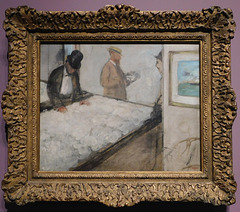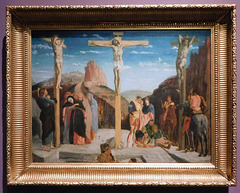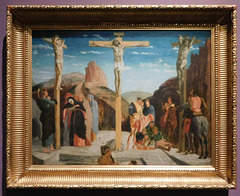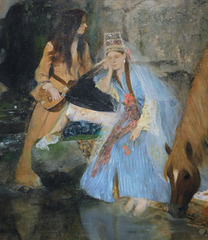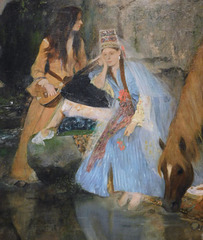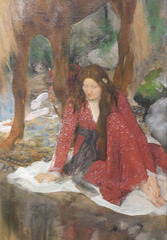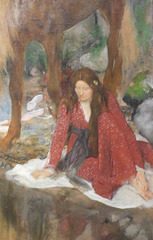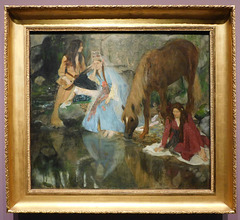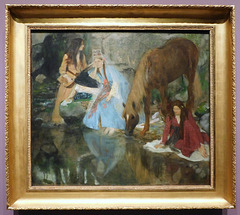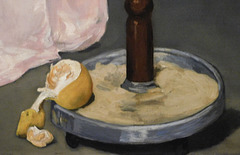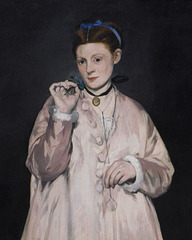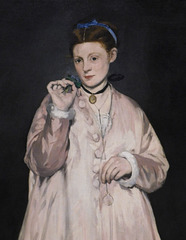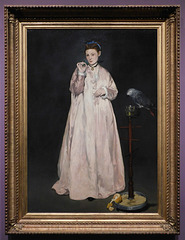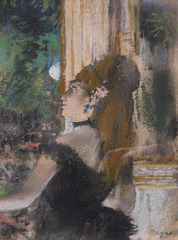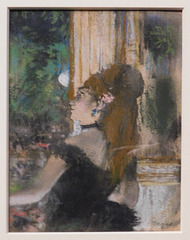LaurieAnnie's photos
Cotton Merchants in New Orleans by Degas in the Me…
| |
|
Title: Cotton Merchants in New Orleans
Artist: Edgar Degas (French, Paris 1834–1917 Paris)
Date: 1873
Geography: Country of Origin France
Culture: French
Medium: Oil on linen
Dimensions: 23 1/8 × 28 1/4 in. (58.7 × 71.8 cm)
Frame: 32 15/16 × 38 3/16 × 3 in. (83.7 × 97 × 7.6 cm)
Classification: Paintings
Credit Line: Harvard Art Museums/Fogg Museum, Gift of Herbert N. Straus (1929.90)
In a letter from New Orleans to James Tissot, Degas wrote, “I am preparing another [painting], less complicated and more spontaneous, better art, where the people are wearing summer dress, white walls, a sea of cotton on the tables.” Set in a light and airy space centered on a bed of tactile cotton, this breezy composition captures the casual transaction of business in the New Orleans office of the artist’s uncle, Michel Musson. One imagines that this is the “Louisiana art” Degas aimed to create, as mentioned in his letters. The seascape on the wall calls attention to the transatlantic trade of cotton, in which his brothers were directly involved as owners of a firm that purchased the raw material on behalf of French merchants.
Text from: www.metmuseum.org/art/collection/search/844642
Cotton Merchants in New Orleans by Degas in the Me…
| |
|
Title: Cotton Merchants in New Orleans
Artist: Edgar Degas (French, Paris 1834–1917 Paris)
Date: 1873
Geography: Country of Origin France
Culture: French
Medium: Oil on linen
Dimensions: 23 1/8 × 28 1/4 in. (58.7 × 71.8 cm)
Frame: 32 15/16 × 38 3/16 × 3 in. (83.7 × 97 × 7.6 cm)
Classification: Paintings
Credit Line: Harvard Art Museums/Fogg Museum, Gift of Herbert N. Straus (1929.90)
In a letter from New Orleans to James Tissot, Degas wrote, “I am preparing another [painting], less complicated and more spontaneous, better art, where the people are wearing summer dress, white walls, a sea of cotton on the tables.” Set in a light and airy space centered on a bed of tactile cotton, this breezy composition captures the casual transaction of business in the New Orleans office of the artist’s uncle, Michel Musson. One imagines that this is the “Louisiana art” Degas aimed to create, as mentioned in his letters. The seascape on the wall calls attention to the transatlantic trade of cotton, in which his brothers were directly involved as owners of a firm that purchased the raw material on behalf of French merchants.
Text from: www.metmuseum.org/art/collection/search/844642
Cotton Merchants in New Orleans by Degas in the Me…
| |
|
Title: Cotton Merchants in New Orleans
Artist: Edgar Degas (French, Paris 1834–1917 Paris)
Date: 1873
Geography: Country of Origin France
Culture: French
Medium: Oil on linen
Dimensions: 23 1/8 × 28 1/4 in. (58.7 × 71.8 cm)
Frame: 32 15/16 × 38 3/16 × 3 in. (83.7 × 97 × 7.6 cm)
Classification: Paintings
Credit Line: Harvard Art Museums/Fogg Museum, Gift of Herbert N. Straus (1929.90)
In a letter from New Orleans to James Tissot, Degas wrote, “I am preparing another [painting], less complicated and more spontaneous, better art, where the people are wearing summer dress, white walls, a sea of cotton on the tables.” Set in a light and airy space centered on a bed of tactile cotton, this breezy composition captures the casual transaction of business in the New Orleans office of the artist’s uncle, Michel Musson. One imagines that this is the “Louisiana art” Degas aimed to create, as mentioned in his letters. The seascape on the wall calls attention to the transatlantic trade of cotton, in which his brothers were directly involved as owners of a firm that purchased the raw material on behalf of French merchants.
Text from: www.metmuseum.org/art/collection/search/844642
Crucifixion after Mantegna by Degas in the Metropo…
| |
|
Crucifixion after Mantegna by Degas in the Metropo…
| |
|
Detail of Mademoiselle Fiocre in the Ballet La Sou…
| |
|
Title: Mademoiselle Fiocre in the Ballet "La Source"
Artist: Edgar Degas (French, Paris 1834–1917 Paris)
Date: ca. 1867–68
Geography: Country of Origin France
Culture: French
Medium: Oil on canvas
Dimensions: 51 1/2 × 57 1/8 in., 166 lb. (130.8 × 145.1 cm, 75.3 kg)
Framed: 63 × 69 × 6 1/4 in. (160 × 175.3 × 15.9 cm)
Classification: Paintings
Credit Line: Brooklyn Museum, Gift of James H. Post, A. Augustus Healy, and John T. Underwood (21.111)
Degas submitted this painting to the 1868 Salon with the title Portrait de Mlle E. F. à propos du ballet ‘La Source,’ referring to Eugénie Fiocre, a famous dancer at the Paris Opera. Although its exhibited title suggests that he intended the work as a portrait, it otherwise gives the impression of a literary or mythological subject. Rather than show the performance, Degas captures the young woman and other dancers at rest during rehearsal, providing little indication of a stage set beyond the pink ballet slippers visible between the horse’s legs.
Text from: www.metmuseum.org/art/collection/search/844733
Detail of Mademoiselle Fiocre in the Ballet La Sou…
| |
|
Title: Mademoiselle Fiocre in the Ballet "La Source"
Artist: Edgar Degas (French, Paris 1834–1917 Paris)
Date: ca. 1867–68
Geography: Country of Origin France
Culture: French
Medium: Oil on canvas
Dimensions: 51 1/2 × 57 1/8 in., 166 lb. (130.8 × 145.1 cm, 75.3 kg)
Framed: 63 × 69 × 6 1/4 in. (160 × 175.3 × 15.9 cm)
Classification: Paintings
Credit Line: Brooklyn Museum, Gift of James H. Post, A. Augustus Healy, and John T. Underwood (21.111)
Degas submitted this painting to the 1868 Salon with the title Portrait de Mlle E. F. à propos du ballet ‘La Source,’ referring to Eugénie Fiocre, a famous dancer at the Paris Opera. Although its exhibited title suggests that he intended the work as a portrait, it otherwise gives the impression of a literary or mythological subject. Rather than show the performance, Degas captures the young woman and other dancers at rest during rehearsal, providing little indication of a stage set beyond the pink ballet slippers visible between the horse’s legs.
Text from: www.metmuseum.org/art/collection/search/844733
Detail of Mademoiselle Fiocre in the Ballet La Sou…
| |
|
Title: Mademoiselle Fiocre in the Ballet "La Source"
Artist: Edgar Degas (French, Paris 1834–1917 Paris)
Date: ca. 1867–68
Geography: Country of Origin France
Culture: French
Medium: Oil on canvas
Dimensions: 51 1/2 × 57 1/8 in., 166 lb. (130.8 × 145.1 cm, 75.3 kg)
Framed: 63 × 69 × 6 1/4 in. (160 × 175.3 × 15.9 cm)
Classification: Paintings
Credit Line: Brooklyn Museum, Gift of James H. Post, A. Augustus Healy, and John T. Underwood (21.111)
Degas submitted this painting to the 1868 Salon with the title Portrait de Mlle E. F. à propos du ballet ‘La Source,’ referring to Eugénie Fiocre, a famous dancer at the Paris Opera. Although its exhibited title suggests that he intended the work as a portrait, it otherwise gives the impression of a literary or mythological subject. Rather than show the performance, Degas captures the young woman and other dancers at rest during rehearsal, providing little indication of a stage set beyond the pink ballet slippers visible between the horse’s legs.
Text from: www.metmuseum.org/art/collection/search/844733
Detail of Mademoiselle Fiocre in the Ballet La Sou…
| |
|
Title: Mademoiselle Fiocre in the Ballet "La Source"
Artist: Edgar Degas (French, Paris 1834–1917 Paris)
Date: ca. 1867–68
Geography: Country of Origin France
Culture: French
Medium: Oil on canvas
Dimensions: 51 1/2 × 57 1/8 in., 166 lb. (130.8 × 145.1 cm, 75.3 kg)
Framed: 63 × 69 × 6 1/4 in. (160 × 175.3 × 15.9 cm)
Classification: Paintings
Credit Line: Brooklyn Museum, Gift of James H. Post, A. Augustus Healy, and John T. Underwood (21.111)
Degas submitted this painting to the 1868 Salon with the title Portrait de Mlle E. F. à propos du ballet ‘La Source,’ referring to Eugénie Fiocre, a famous dancer at the Paris Opera. Although its exhibited title suggests that he intended the work as a portrait, it otherwise gives the impression of a literary or mythological subject. Rather than show the performance, Degas captures the young woman and other dancers at rest during rehearsal, providing little indication of a stage set beyond the pink ballet slippers visible between the horse’s legs.
Text from: www.metmuseum.org/art/collection/search/844733
Mademoiselle Fiocre in the Ballet La Source by Deg…
| |
|
Title: Mademoiselle Fiocre in the Ballet "La Source"
Artist: Edgar Degas (French, Paris 1834–1917 Paris)
Date: ca. 1867–68
Geography: Country of Origin France
Culture: French
Medium: Oil on canvas
Dimensions: 51 1/2 × 57 1/8 in., 166 lb. (130.8 × 145.1 cm, 75.3 kg)
Framed: 63 × 69 × 6 1/4 in. (160 × 175.3 × 15.9 cm)
Classification: Paintings
Credit Line: Brooklyn Museum, Gift of James H. Post, A. Augustus Healy, and John T. Underwood (21.111)
Degas submitted this painting to the 1868 Salon with the title Portrait de Mlle E. F. à propos du ballet ‘La Source,’ referring to Eugénie Fiocre, a famous dancer at the Paris Opera. Although its exhibited title suggests that he intended the work as a portrait, it otherwise gives the impression of a literary or mythological subject. Rather than show the performance, Degas captures the young woman and other dancers at rest during rehearsal, providing little indication of a stage set beyond the pink ballet slippers visible between the horse’s legs.
Text from: www.metmuseum.org/art/collection/search/844733
Mademoiselle Fiocre in the Ballet La Source by Deg…
| |
|
Title: Mademoiselle Fiocre in the Ballet "La Source"
Artist: Edgar Degas (French, Paris 1834–1917 Paris)
Date: ca. 1867–68
Geography: Country of Origin France
Culture: French
Medium: Oil on canvas
Dimensions: 51 1/2 × 57 1/8 in., 166 lb. (130.8 × 145.1 cm, 75.3 kg)
Framed: 63 × 69 × 6 1/4 in. (160 × 175.3 × 15.9 cm)
Classification: Paintings
Credit Line: Brooklyn Museum, Gift of James H. Post, A. Augustus Healy, and John T. Underwood (21.111)
Degas submitted this painting to the 1868 Salon with the title Portrait de Mlle E. F. à propos du ballet ‘La Source,’ referring to Eugénie Fiocre, a famous dancer at the Paris Opera. Although its exhibited title suggests that he intended the work as a portrait, it otherwise gives the impression of a literary or mythological subject. Rather than show the performance, Degas captures the young woman and other dancers at rest during rehearsal, providing little indication of a stage set beyond the pink ballet slippers visible between the horse’s legs.
Text from: www.metmuseum.org/art/collection/search/844733
Detail of the Young Lady in 1866 by Manet in the M…
| |
|
Detail of the Young Lady in 1866 by Manet in the M…
| |
|
Detail of the Young Lady in 1866 by Manet in the M…
| |
|
Detail of the Young Lady in 1866 by Manet in the M…
| |
|
Young Lady in 1866 by Manet in the Metropolitan Mu…
| |
|
Detail of The Singer by Degas Metropolitan Museum…
| |
|
The Singer by Degas Metropolitan Museum of Art, De…
| |
|



